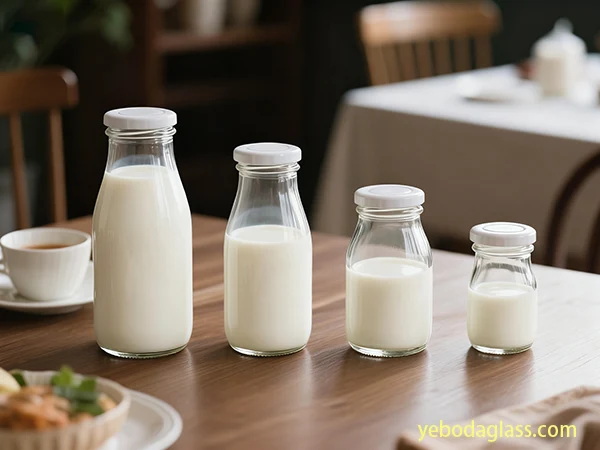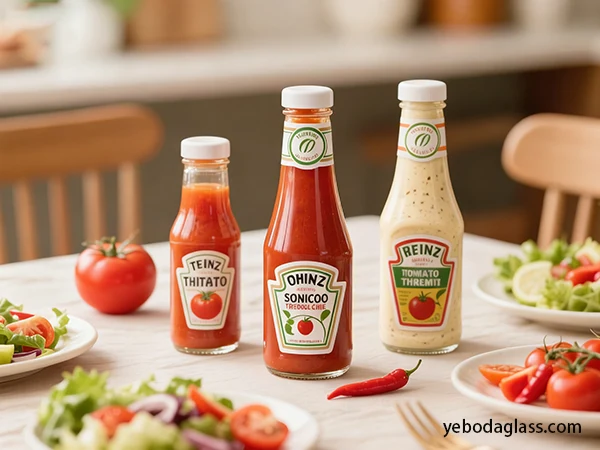PET'in hafif ağırlığı ve dayanıklılığı her pallete için daha fazla birim sunar, depolama ve taşıma alanını en üst düzeye çıkarır. Bu, camla karşılaştırıldığında daha iyi depo kullanımına yol açar. PET fıçıları da yığılmaya uygundur, bu da alan optimizasyonunu daha da artırır.
Bu eliptede sığır üreticilerinin yanı sıra YEBODA'ya altın standart süt cam şişe tedarikçilerini seçmede yardımcı olan bu kılavuz, şişe ihtiyaçlarını koruyan, tedarikçi değerlendirmesi, lojistik, maliyet değerlendirmesi ve uzun vadeli ortaklıklarla bağımlı bir yaklaşım sunar. Sığır sektörü sürdürülebilir, üst sınıf ambalajlara doğru bir dönüşüm正在进行, cam şişeler geri dönüşümlülük, nötrite ve algılanan olağanüstülük nedeniyle ön plana çıkar. Bu çerçeve yeterli sertifikasyonları, teslim zinciri dayanıklılığını ve dekorasyon stratejilerini entegre eder, rekabetçi bir pazarda bilinçli seçim yapımını sağlar.
2. Sığır Markanızın Şişe İhtiyaçlarını Tanımlama
Sığır markanızın özel şişe ihtiyaçlarını tanımlama, işletme hedefleriyle işletimsel ihtiyaçları, marka tanıtımları ve pazar konumunu uyumlu hale getiren önemli ilk adımdır.
투명도:
Yıllık hacim tedarikçi seçimine temel oluşturur. Özel siparişler genellikle önemli MOQ'lar ve öncelikli yatırımlar gerektirir. Küçük işletmeler standart şişeleri tercih edebilirken, YEBODA gibi büyük markalar yüksek hacim kapasitesi ihtiyacı vardır. Tedarikçiler mevcut kapasitesini ve gelecekteki büyümeye yönelik ölçeklenebilirliği göstermelidir. Kapsamlı bir kapasite denetimi üretim kapasitesini, dalgalanma siparişleri için esnekliği, önleyici bakımı ve ERP/MRP sistemlerinin karmaşıklığını değerlendirmelidir.
2.2. Özel Şişe Tasarımı: Boyutlar, Şekiller ve Boyun Sonuçları
Şişe tasarımı marka ayrımının ve tüketici çekiminin başlıca faktörüdür. 2025 trendleri sürdürülebilirlik, lüksleştirme ve kişiselleştirmeye odaklanmaktadır.
- Estetik ve Fonksiyonellik:
- Kişiselleştirme: Benzersiz görseller, özel logo'lar veya yazıtlar güçlü bir marka kimliği oluşturur.
- Minimalizm ve Gerçekçilik: Basitlik hakimdir, işlenmiş veya damgalanmış cam şişeler zamanla geçen bir estetiği çağrıştırır.
- Doku Ambalajı: Gerçekçi dokular hammade kaynakları çağrıştırır ve dokusal bir deneyim sağlar.
- 4.1. Kapalı Döngü Geri Dönüşüm ve Sertifikalar Üretim maliyetlerini ve çevresel etkiyi azaltan " hafifletme " ve ince cam trendleri ortaya çıkmış, yapısal bütünlükle dengelenmiştir.
- Yaratıcı Kapanışlar: Kullanılabilirliği ve estetik çekimi artırır.
- Akıllı Görüntüleme İzleyicileri: Termokromik boya hassas ürünler gibi probiyotikler için soğuk zincir kırılmalarını göstererek güven inşa eder.
- Boyun Sonuçları ve Kapanışlar:
- Standartlaşma: GPI ve SPI yönergeleri şişeler ve kaplar arasında evrensel uyumluluğu sağlar.
- İlişki Tasarımı: Konteyner boyun ve kap ilgi stilinin hassas bir şekilde eşleşmesi, güvenli ve sızmaz bir sızdırmazlık sağlar. Yaygın boyun sonuçları 400, 410 ve 415'tir.
- İmtihan Evidansı Özellikleri: Gıda ürünleri için kritiktir, açılma veya imtihanın anında işaretini verir.
- Dağıtım Kapanışları: Kullanıcı konforunu artırır ve hassas uygulama için.
- Sürdürülebilir Kapanışlar: Yeni yenilikler lif tabanlı (örneğin, Blue Ocean Kapanışları) ve 100% PCR rezini (PolyCycle PCR) içerir. PET kapağı yaygındır. "Bump Cap" bozulmayı gösterir.
2.3. Gerekli Kalite Sertifikasyonları ve Malzeme Güvenliği
Süt ürünleri için sert kalite ve güvenlik sertifikalarına uyum kaçınılmazdır, ürün bütünlüğünü, tüketiciler sağlığını ve yasal uyumu sağlar.
- Uluslararası ve Ulusal Standartlar:
- ISO 7086-1:2017: Gıda teması camdan kurşun ve cadmiyum serbest bırakılmasına yönelik test yöntemlerini tanımlar.
- CCC Sertifikasyonu: Pozitif ülkelerde (örneğin, Çin) zorunludur.
- FDA Uyumu (ABD): FDA cam kutuları dolaylı gıda bileşenleri olarak düzenler; soda-lime cam genellikle güvenli olarak tanımlanır (GRAS).
- AB Gıda Temas Yönetmelikleri: AB ihracatı için Yönetmelik (EC) No 1935/2004'ün uyumlu olması esastır.
- Özel Şirket Uyum: HSIL Limited ve Piramal Glass Ltd gibi güvenilir üreticiler FSSAI, AB yemek koruması ve USP Tip-III cam standartlarını takip eder.
- Kalite Güvence Sistemleri ve Üçüncü Taraf Onayları:
- ISO 9001 ve GMP: Sağlam QA yapıları düzenli bir birinci sınıf, operasyonel mükemmellik ve yasal uyumu sağlar.
- Üçüncü Taraf Sertifikasyonları: Bağımsız kuruluşlar (örneğin, NSF International, Intertek, SGS), denetimler ve deneyler aracılığıyla uyumu doğrular.
- Malzeme Güvenliği: Kapağa veya katkı maddelerindeki tüm plastikler, metaller ve elastomerler uzun ömürlü, kimyasal olarak nötr ve yemek kaliteli olmalıdır, leke bırakmamak için.
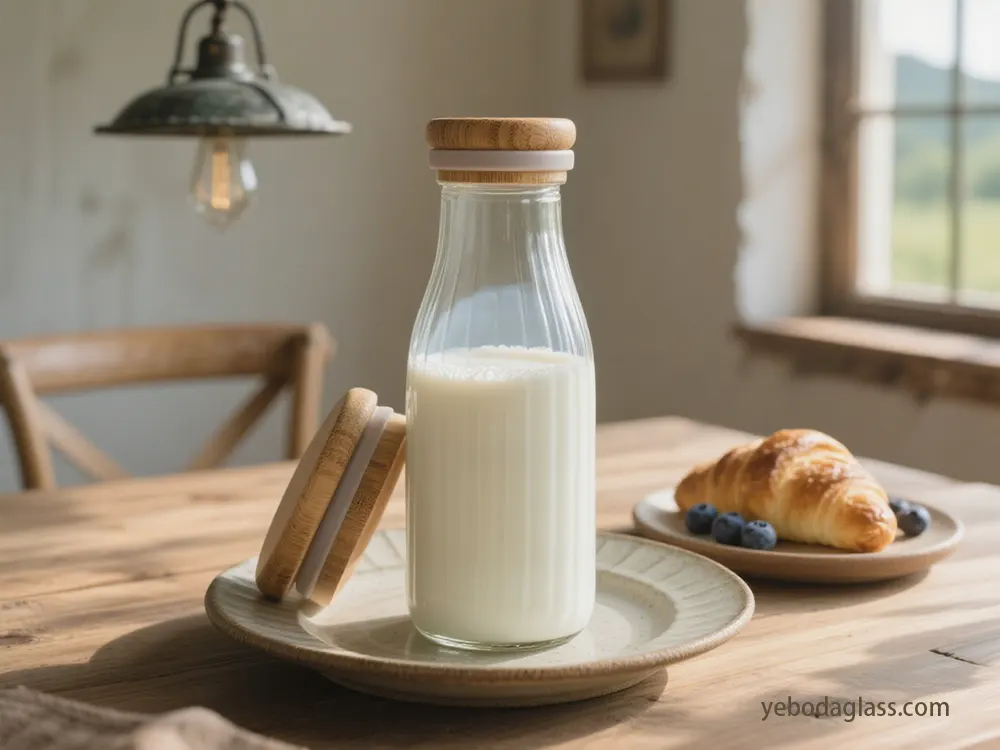
2.4. Özel Markalama ve Dekorasyon İhtiyaçları
Özel süsleme, amaca yönelik bir şişeyi belirli bir marka aracıya dönüştürür, dayanıklılık, ücret ve çevresel izdişini etkiler.
- Dekorasyon Teknikleri:
- Serigrafi Baskı: Çeşitli, fiyat etkin yaklaşım, boyalar veya UV ile kurulan inklek kullanarak dayanıklı, 360 derece baskılar sağlar.
- Organik Boyalar: Yoğun üretim için çevre dostu bir alternatif, renkli portreler oluşturur; şişeler tamamen geri dönüştürülebilir.
- Seramik Baskı: Üstün dayanıklılık ve aşınma direnci; boyalar yüksek sıcaklıkta firing sırasında camla kalıcı olarak birleşir.
- Frit Baskı: Boyayı sıcaklıkta camla birleştirerek, çok yüksek aşınma direnci sağlayan dekorasyonlar üretir.
- Foil Stamping: Metalik veya renkli foil uygulayarak lüks görünüm sağlar.
- Electroplating: Güzelliği artırır ve korozyon direncini güçlendirir.
- Spray Coating: Özel renkler, koruyucu kaplamalar ve benzersiz dokularla dayanıklılığı ve görsel çekiciliği artırır.
- Laser Engraving/Etching: Laserle cam yüzeyini değiştiren hassas bir teknik, lüks ürünlerde tercih edilir.
- Dayanıklılık ve Yerleştirme:
- UV Yağı Yerleştirme: Optimum yerleştirme genellikle belirli hazırlıklar gerektirir, örneğin düz camın "hava tarafı"na basma.
- Hazırlık: Cam yüzeyini alkol ile temizlemek esastır.
- Yerleştirme İyileştiricileri: Natron G1 UV gibi iyileştiriciler genellikle gerekir, özellikle soğuk doldurulmuş şişelerde kondensasyona eğilimli olanlarda.
- Yanma Tedavisi: Gelişmiş ön tedavi sistemleri (örneğin, Pyrosil kitleri) yağın yerleştirilmesini önemli ölçüde artırır, böylece süslü cam eşyalar birçok yıkıma dayanabilir.
- Yağ Kimyası: Yağ kimyası hayati bir rol oynar; bazı özel UV yağları basma sonrası ısıtma ve UV kurulumu gerektirir.Isimat’ın UVitro Teknolojisi, mükemmel yerleştirme olan organik UV yağları kullanır, genellikle plazma ön tedavisi ile birlikte.
- Maliyet Etkinliği ve Ekolojik Dostluk:
- Maliyet Faktörleri: Maliyet malzeme (kuvars, ambar, yeşil), sipariş miktarı ve özelleştirme karmaşıklığına bağlıdır.Kusursuz kalıplar önemli bir öngörülebilir yatırımdır ($1,500-$11,000).Prototip maliyeti $500-$2,000.Küçük ölçekli üretim $1-$3 başına şişe; daha küçük siparişler $5-$10.
- Süreler: Özel siparişler için 6-12 hafta bekleyin; özel kalıp oluşturma birkaç ay sürebilir.
- Sürdürülebilirlik: Cam sonsuz kez geri dönüştürülebilir. Özel ekran baskısı geleneksel etiketleri ortadan kaldırarak atığı en aza indirir.Ekolojik dostu yağ seçenekleri VOC emisyonlarını azaltır.Bazı şirketler ağır metal içermeyen süreçleri ve yeşil enerji kullanır.
3. Tedarikçi Yeteneklerinin Değerlendirilmesi ve Kalite Güvence
Potansiyel süt cam şişe tedarikçilerinin titiz bir şekilde değerlendirilmesi, tutarlı kalite, güvenlik ve üretim verimliliği sağlamak için kritiktir.
3.1. Üretim Kapasitesi ve Üretim Uzmanlığı
무게:
- Kapasite Denetimi: Kapsamlı bir denetim, üretim yeteneğini, akıllı siparişlere olan esnekliği, önleyici bakım takvimlerini ve ERP/MRP sistemlerinin kullanımını değerlendirir.
- Üretim Aşamaları ve Kontrol: Tüm süreci anlamak—doğal malzeme hazırlama, eritme, şekillendirme, ısıl işlem, yüzey işleme, muayene, paketleme—anahtardır. hassas sıcaklık kontrolü kusurları önler.Proprietè ısıl işlem içsel baskıları rahatlatır.
- Teknolojik Gelişim: Üreticiler aşırı hassas kalıplar, otomatik baskılar ve üstün yüzey işleme teknolojilerini kullanarak düzenli, daha yüksek performanslı ve daha az kusurlu ürünler sağlarlar.
3.2. Gıda Standartlarına Uyum
Yoğun süt yönergelerine rağmen, bir tedarikçinin gıda standartlarına olan tutarlı bağlılığı ilkördündedir.
- GFSI Standartları: Global Gıda Güvenliği İnisiyatifi (GFSI) standartlarına uyum, gıda güvenliğine olan bağlılığı gösterir ve paketleme tedarikçileri için belgelenmiş onay süreçlerini zorunlu kılar.
- Onaylanmış Tedarikçi Listesi: Tedarikçi, tüm malzemeler, yemek teması paketlemesini de dahil etmekte, dikkatlice yönetilen bir onaylanmış tedarikçi listesi tutmalıdır.
- Yönetmelik Uyumu: Belirli bölgesel ve ulusal düzenlemelere (FDA, AB Gıda Teması Yönetmelikleri, FSSAI) uygun olunmasını sağlayın. Ünlü üreticiler USP Tip-III cam standartlarına uygun olduklarını açıkça belirtirler.
- Kalite Güvence Sistemleri: Güçlü ISO 9001 ve GMP sistemleri tutarlı kalite, izlenebilirlik ve sürekli yasal uyumu sağlar.
- Malzeme Güvenliği: Şarküterilerde ve bileşenlerdeki tüm malzemeler dayanıklı, kimyasal inert ve gıda standartlarına uygun olmalıdır, bu sayede zararlı madde geçişleri önlenir.
3.3. Güçlü Kalite Kontrol Süreçleri
Bir tedarikçinin kalite kontrol (QC) süreçleri, kusurları önlemek, ürün bütünlüğünü sağlamak ve tüketiciler güvenliğini sağlamak için hayati öneme sahiptir.
- Kalite Kontrol Önemi: Yoğun QC kusurları önler, üretim verimliliğini optimize eder, atığı azaltır, maliyetleri düşürür ve pazar rekabet gücünü korur.
- Kusur Tanıma ve Sınıflandırma: Tedarikçilerin kusurları tanıma, sınıflandırma ve ele alma için net prosedürlere ihtiyacı vardır. Yaygın yüzey kusurları kabarcıklar, çizikler, çatlaklar ve kırıkları içerir.Kusurlar ciddiyete göre Sıfır (Minor), Önemli (Major) veya Kritik olarak sınıflandırılır.
- Muayene Yöntemleri: Tamamlanmış şarküteriler kusurlar için (manuel veya otomatik) görsel muayene geçirirler.Automated sistemler algoritmalar ve yüksek hızlı kameralar kullanır.
- Test Prosedürleri: Şarküteriler darbe, iç baskı ve sıcaklık değişimleri için katı test edilir.Düzenli test aralıkları esastır; bir şarküteri başarısız olursa, üretimden dört daha test edilir ve herhangi bir yeniden test edilen şarküteri başarısız olursa, tüm üretim serisi karantinaya alınır.
- Doğal Malzeme Kalitesi: Silika kum kalitesi ilkördündedir, bu da kirlilikten arınmış olması gerekmektedir.
- Fonksiyonel Standartlar: Kaplar, doldurma hatlarında pürüzsüz çalışmak ve ürünü güvenli bir şekilde içerme için katı fonksiyonel muayenelere tabi tutulmalıdır.
- Görünüm ve Kimyasal Kontrol: Rutin görünüm muayeneleri ve ağır metaller için kimyasal kontroller gıda güvenliği uyumunu sağlar.
- Takım Çalışması: Sıkıntılı yüksek kaliteli şişe üretimi işbirlikçi bir takım çalışması gerektirir.
4. Lojistik, Teslimat Süreleri ve Tedarik Zinciri Dayanıklılığı
Şarap markaları için cam şişe satın alma lojistiğini optimize etmek, benzersiz zorluklar göz önüne alındığında önceliklidir.
4.1. Tedarikçi Yakınlığı ve Taşımacılık Verimliliği
4 pezzi per cartone
- Yakınlık Avantajları: Yakın tedarikçilerden temin etmek taşımacılık ücretlerini azaltır, mesafenin, miktarın, ağırlığın ve yakıt fiyatlarının önemli bir maliyet bileşenine dayanır.
- Accessori completi: una spazzola per la pulizia è inclusa per una pulizia accurata e un cappuccio nero è incluso come alternativa o riserva. Cam şişeler plastikten önemli ölçüde ağır olduğu için, hammaddeden nihai teslimata kadar taşımacılık maliyetleri yüksektir. Ağırlığın artması da depolama maliyetlerini artırır.
- Boyut Ağırlığı: Taşıma maliyetleri hem fiziksel hem de boyut ağırlığından etkilidir. Paket boyutunu azaltmak ve uygun paketleme yapmak maliyetleri azaltır.
- Taşımacılık Optimizasyonu: Yüklerin konsolide edilmesi hacim indirimlerinden yararlanır. Gelişmiş taşımacılık yazılımları süreçleri otomatikleştirir ve paket boyutlarını optimize eder.
- Soğuk Zincir ve Paketleme Korunumu: Cam şişeler soğuk zincire ihtiyaç duymaz ancak süt ürünleri ihtiyaç duyar. Süt lojistiği hızlı taşımacılık ve soğuk araçlarla ve izleme yoluyla katı sıcaklık kontrolü gerektirir. Paketleme ürünleri sıcaklık/veya nem değişimlerinden korumalıdır.
4.2. Öncelikli Teslimat Süreleri
Teslimat süreleri stok yönetimi ve üretim planlamasında kritiktir, pazar yanıtını etkiler.
- Özel Siparişler: Özel cam şişe siparişleri daha uzun teslimat süreleri gerektirir: küçük siparişler için 6 hafta, büyük miktarlar/ Karmaşık tasarımlar için 12 hafta veya daha fazla.
- Özel Kalıplar: Benzersiz tasarımlar için kalıp oluşturma zaman yoğun bir süreçtir, genellikle birkaç ay sürer.
- Teslimat Süresi bir KPI olarak: Teslimat süresi tedarikçi performansının ana performans göstergesi (KPI) olarak, siparişten sonra teslimat süresini ölçer. Daha kısa, öngörülebilir teslimat süreleri verimliliği artırır, tutma maliyetlerini azaltır ve pazar yanıtını iyileştirir.
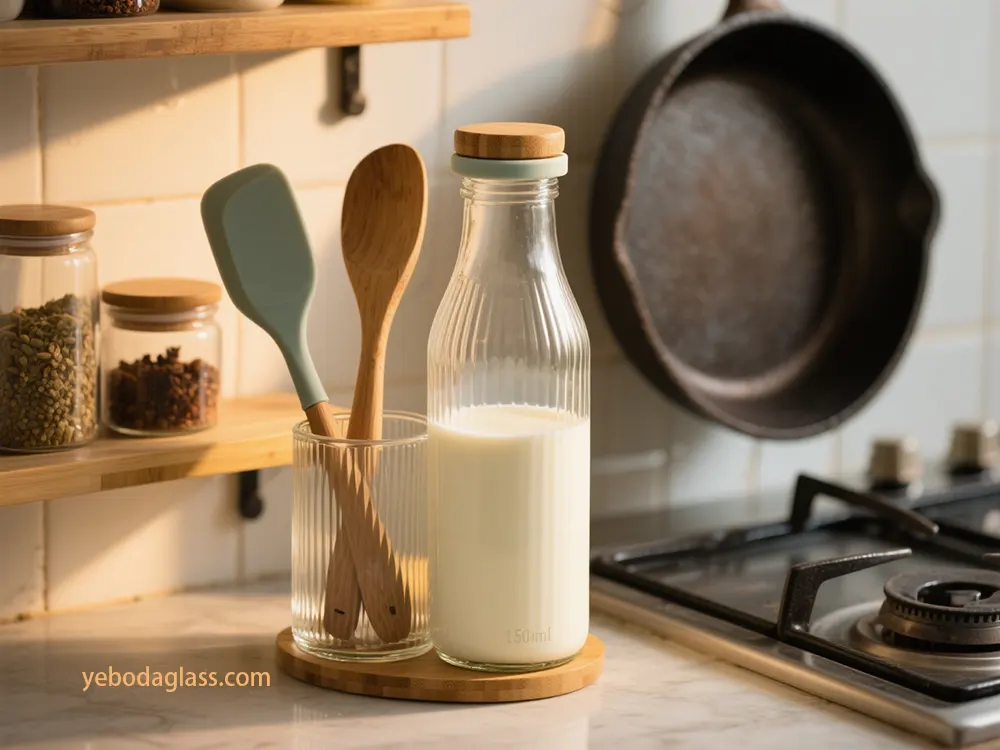
4.3. Tedarik Zinciri Dayanıklılığı
Dayanıklı teslimat zinciri oluşturma kesintileri azaltır ve pahalı süt ürünlerinin tutarlı ürün mevcudiyeti sağlar.
- Tedarikçilerin Diversifikasyonu: Bölgesel kaynak çeşitlendirme tek bir kaynağa bağımlılığı azaltır, yerel kesintilerin etkisini azaltır.
- Risk Yönetimi ve Değerlendirme: Tedarik zinciri zayıflıklarını belirlemek için düzenli risk testleri yapın, tedarikçi güvenilirliği, jeopolitik riskler ve çevresel kesintiler okuyun. Resmi tedarikçi risk yönetim politikası finansal istikrar, kalite kontrol, yasal uyum, çevresel sürdürülebilirlik ve jeopolitik faktörleri kapsamalıdır.
- Acil Planlama: Kesin acil planlar geliştirin, hareketler, sorumluluklar, zaman çizelgeleri ve başarı kriterlerini açıklamak için kesinti olasılıklarına yönelik planlar oluşturun. Ön sınıflandırılmış fırsat sağlayıcıları anahtardır.
- Esneklik ve Stok Optimizasyonu: Değişen taleplere uyum sağlama esnekliğine sahip olun. Stratejik arz stoğu gibi kritik malzemeler (cam şişe gibi) kesintileri engellemek için koruma sağlar.
- Sürdürülebilirlik Entegrasyonu: ESG faktörlerinin değerlendirilmesi tedarikçi risk değerlendirmelerinde kritik öneme sahiptir. Sürdürülebilir cam üretimi yenilenebilir enerji kullanarak fiyatları düşürür ve karbon emisyonlarını azaltır. Camın geri dönüşümü safsız malzeme ihtiyacını, güç alımını ve kirliliği azaltır; her ton geri dönüştürülmüş cam 246 kg CO2 tasarruf eder. Evrilen ESG kuralları da satıcıların sürdürülebilirliğinin uyumun hayati bir parçası olduğunu sağlar.
- Görünürlük ve Tahmin İçin Teknolojik İyileştirmeler:
- Blokzincir: Paket teslim zincirinde şeffaflığı, takip edilebilirliği ve verimliliği artırır, QR/NFC/RFID etiketleri aracılığıyla taklitleri durdurur.
- Yapay Zeka İle Tahmin Analizi: Kesintileri öngörür, stoku optimize eder ve talep tahminlerini iyileştirir. Yapay zeka büyük verileri derinlemesine analiz ederek alımın ve tahminin otomatikleştirilmesini sağlar.
- Anlık İzleme: IoT sensörleri ve RPA operasyonların ve lojistiğin 360 derecelik bir görünümünü sağlar, anında yanıtlamalar sağlar.
- Süt-Specific Tedarik Zinciri Düşünceleri:
- Veri Şeffaflığı: Veri şeffaflığının eksikliği işbirliğini engeller, verimlilikleri düşürür. Anlık görünüm hayati öneme sahiptir.
- Doğru Stok Yönetimi: Ürün atığını önlemek ve tutarlı erişilebilirlik sağlamak için esastır.
- Yasal Uyumluluk Entegrasyonu: Uyum kontrolü işlemlerini dijital platformlara entegre etmek riski azaltır.
- Mevcut Sistemler: Yenilenmiş sistemler veri doğruluğunda ve anlık görünümde eksiklikler içerebilir.
- Büyükanlaması Etkisi Azaltma: Genetik Algoritmalar (GAs) "Büyükanlaması Etkisini" yumuşatır.
- Bölgesel Acil Planlama: Bölgesel düzeyde emtia stoğu tutmak kıtlıklar sırasında hızlı teslimat sağlar.
5. Maliyet Analizi ve Değer Tezleri
YEBODA'nın cam süt şişeleri için kapsamlı maliyet analizi, birim fiyatı aşarak, Tam Maluliyet Maliyeti (TCO) için tam finansal etkileri ve uzun vadeli değeri kapsar.
5.1. Şişe Başına Budget Aralığı
Cam şişe fiyatları boyut, kalınlık, özel tasarım ve sözleşme doğasına göre önemli ölçüde değişir.
- Ortalama Fiyat Aralığı: Fiyatlar genellikle 0.18'den X.XX'e kadar birimlere göre değişir. 12 ons altı: 200-800 adet 2,500 şişe ile aynı; 12 ons üzerinde: 1,000-6,500 adet 2,500 şişe ile. Standart, yüksek hacimli şişeler: 0.1-0.5 ABD Doları; özel tasarım: 0.1-0.5 ABD Doları; üst sınıf/özel tasarım: 1-3 ABD Doları veya daha fazla.
- Ham Madde Maliyetleri: Temel malzemeler kumtaşı, sodyum karbonat ve kireçtaşı içerir. Geri dönüşümlü cam (cullet) oranı maliyet ve sürdürülebilirliği etkiler.
- Üretim Maliyetleri: Substantial enerji maliyetleri (enerji yoğun), işçi ve makine bakımı içerir.
- Özel Tasarım: Özel tasarımlar, benzersiz kalıplar ve özel decolasyon nedeniyle maliyetleri artırır.
- Pazar Trendleri: YEBODA pazar trendleri ve ham madde fiyat dalgalanmalarını takip etmelidir. ABD'de cam fiyatları 2022-2025 arasında %3.61 artış bekleniyor.
5.2. Sahip Olma Maliyeti (TCO)
TCO cam şişenin yaşam döngüsü boyunca tüm maliyetleri bir araya getirerek, gizli maliyetleri ve tasarrufları ortaya çıkarır.
- Satın Alma Fiyatı Ötesinde: Birim fiyat bir başlangıç noktasıdır; birçok gizli ve dolaylı maliyet ekonomik fizibiliteyi etkiler.
- Taşımacılık ve Lojistik Maliyetleri: Cam şişeler plastikten önemli ölçüde daha ağır olduğu için taşıma ve depolama maliyetleri önemli ölçüde daha yüksektir. Stratejik tasarım ( hafifletme), büyük ölçekli satın alma ve yakınlarda kaynaklanma bu maliyetleri azaltabilir.
- Ağır Olma Oranları: Cam, taşıma, işleme ve doldurma hatlarında plastikten daha fazla kırılgandır, bu da ürün kaybı, atık, hat durumu ve güvenlik sorunlarına yol açar.
- Kalite Kontrol Maliyetleri: Cam şişeler için katı QC, işçi ve özel ekipmanlar dahil olmak üzere işletim maliyetini artırır.
- Hat Verimliliği: Camla ilgili kırılma ve işleme sorunları doldurma hatının verimliliğini azaltabilir, bu da üretim hacmini ve işletim maliyetini artırır.
- Hayat Sonu Maliyetleri ve Yeniden Kullanılabilirlik:
- Geri Dönüşüm Altyapısı: Sonsuz geri dönüşüm olmasına rağmen, maliyet-fayda ve çevresel etkiler yerel geri dönüşüm programının verimliliğine bağlıdır.
- Yeniden Kullanılabilir Sistemler: Yeniden kullanılabilir cam şişeler, yeterli yeniden kullanım döngüsü (genellikle 25-30) elde ederse maliyet etkin ve çevresel olarak tercih edilebilirdir.
- Yıkanma ve Sterilizasyon: Geri dönüşümlü sistemler için toplanma, ters lojistik, yıkanma ve sterilizasyon için önemli maliyetler TCO'ya dahil edilmelidir.
- Tüketiciler Davranışı: İade edilebilir uygulamaların başarısı, müşterinin şişeleri iade etme istekine dayanır; işlevsizlik büyük bir engel olabilir.
5.3. Değer Teklifi ve Sürdürülebilirlik Değerlendirme
Ekonomik harcamaların ötesinde, uygun değer ürün güzelliği, taşıyıcı güvenilirliği ve emblemin sürdürülebilirlik istekleriyle uyumluğu içerir.
- Yaşam Döngü Değerlendirmesi (LCA): Cam ve plastik arasındaki çevresel etkileri karşılaştırmak için gereklidır; ham doküman çıkarma, üretim, taşımacılık, kullanım ve yaşam sonuna dair düşünülür.Bazı LCA'lar camın ağırlığı ve güç yoğun üretimi nedeniyle plastikten daha düşük çevresel etkisi olacağını önerir.
- CO2 emisyonları ve su kullanımı: Cam üretimi ve taşımacılık CO2 emisyonlarına katkıda bulunur. Döndürülmüş cam kullanımının artması enerji tüketimini ve emisyonları azaltır. Döndürülmüş şişeler için yıkama/sterilizasyon önemli miktarda su gerektirir.
- Yeniden Kullanmanın Çevresel Avantajları: Yeniden kullanılabilir cam şişeler belirli bir yeniden kullanım döngü sayısından sonra (örneğin, 0.5L için 3, 2L için kadar 25) çevresel olarak tercih edilebilir hale gelir.
- Bölgesel Farklılıklar: Optimum paketleme bölge faktörlerine göre değişir: geri dönüşüm altyapısı, taşımacılık maliyetleri ve tüketici tercihleri.
- Tedarikçi Sürdürülebilirliği: Tedarikçileri gösterilen sürdürülebilirlik uygulamalarına göre değerlendirin: yenilenebilir enerji, su yönetimi, ekolojik dostu malzemeler. Sürdürülebilirlik kriterlerini net olarak tanımlayın, şirketin ESG hedefleri ve düzenleyici gereksinimlerle uyumlu hale getirin.
6. Stratejik Tedarikçi Seçimi ve Ortaklık Geliştirme
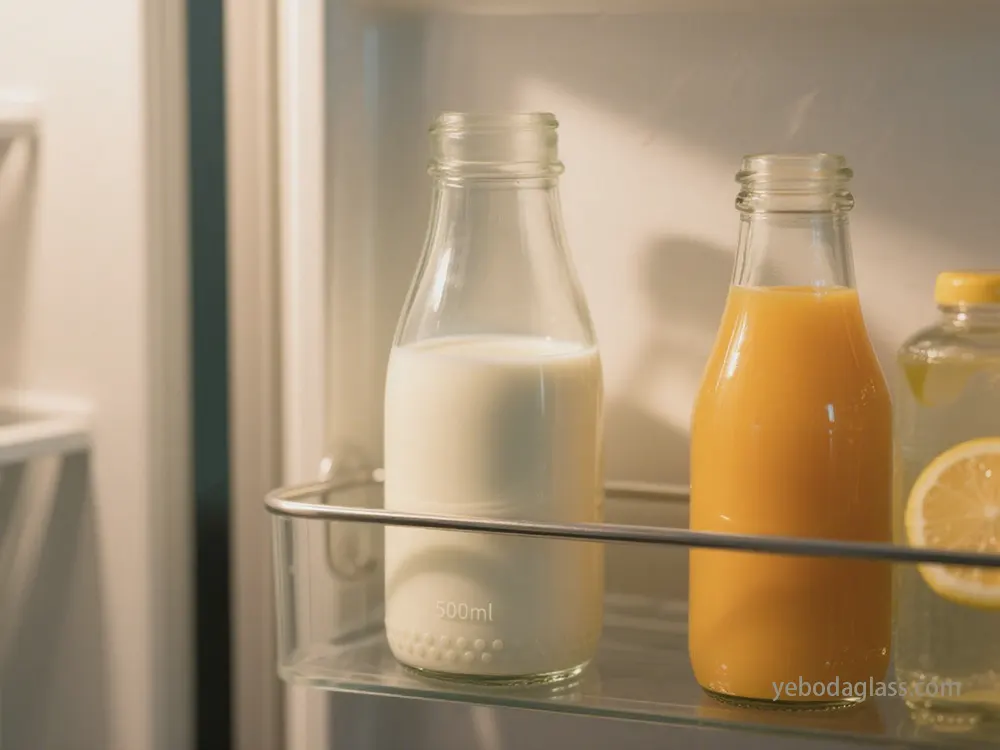
Son aşama, titiz inceleme, kısa listeleme ve uygun sütun cam şişe tedarikçilerinin seçilmesini içerir; bunu uzun vadeli, karşılıklı fayda sağlayan ilişkilerin geliştirilmesi izler. YEBODA, stratejik ortaklıklara geçerek tedarik zincirini farklılaştırabilir.
6.1. Yapılandırılmış Tedarikçi Seçimi ve Hukuki Tedarik
Bir titiz metodoloji, maliyet etkinliği ile kalite ve güvenilir hizmeti birleştiren en iyi genel değeri sunan tedarikçileri belirler.
- Tedarikçi Niteliklendirme Süreci: Tanıma, değerlendirme, kabul, sürekli izleme ve disqualifikasyon içeren çok adımlı bir süreç. Bu katı düzenleyici beklentilerle uyumludur.
- Risk Değerlendirme ve Yönetimi: Finansal istikrar, kalite kontrol, düzenleyici uyum, çevresel sürdürülebilirlik ve jeopolitik faktörleri kapsayan kapsamlı bir tedarikçi risk yönetim politikası uygulayın. Dayanıklı, kriter tabanlı bir model kullanın. Değerlendirmeleri NIST CSF v2.0, ISO 27001 ve ISO 13485 gibi endüstri çerçeveleriyle uyumlu hale getirin. Yeterli hukuki tedarik içeriği, yerinde ziyaretler yaparak yapın.
- Onaylanmış Tedarikçi Listesi: Meticilten yönetilen, düzenli güncellenen onaylanmış tedarikçi listesini tüm ilgili personel tarafından erişilebilir hale getirin.
- Test Çalışmaları ve Spesifikasyonlar: Potansiyel tedarikçilerle belirli kriterlerle (skor kriterleri, spesifikasyon uyumu, kalite incelemeleri) titiz test çalışmaları yaparak onların gereksinimleri karşılama yeteneklerini objektif olarak belirleyin.
- Kalite Kontrol Doğrulaması: Cam/plastik kalitesi, kapanım bütünlüğü, kap kalitesi, etiket/baskı kalitesi, renk karşılaştırması ve şişe/şaraplık şekli, boyut, ağırlık, kapasite, şeffaflık ve kalınlık kapsayan kapsamlı incelemeler uygulayın. Sadece REACH, AB Gıda Temas Yönetmeliği ve 94/62/EC Yönergesi ile kesin uyumluluk sağlayın. Üretim öncesi numuneleri onaylamayı talep edin. Üretim merkezinin tam şeffaflığını talep edin ve doğrudan denetim ve denetim izni alın.
- Tedarikçi Niteliklendirme SOP: Yeni tedarikçiler paketleme malzemesi sağlamadan önce QA tarafından resmi niteliklendirme ve onaydan geçmelidir. KPI'lar ve risk temelli izleme stratejileri sürekli uyumu sağlar.
6.2. Sözleşme Müzakereleri
Etkili sözleşme müzakereleri fiyat, teslimat, kalite ve telif hakları koruması için avantajlı şartlar sağlar.
- Ana Sözleşme Maddeleri:
- Kalite Standartları: Cam şişe için net kalite beklentileri ve koşullarını açıkça tanımlayın; tutarsız başarısızlık maddi ihlal oluşturmalıdır.
- hacim gereksinimleri: Miktarları, AOB/sınırları ve hacim ayarlayıcı hükümleri net bir şekilde belirtin.
- Fiyat Modelleri ve Düzenlemeleri: Yaygın modeller hacim bazlı ve birim bazlı fiyatlandırma içerir. Karşılaştırılmış maliyet fiyatlandırması için maliyet bileşenlerinin şeffaf anlaşılmasını sağlayın. Fiyat ayarlayıcı mekanizmaları tanımlayın.
- İnsan Kaynakları (IP) Hakları: Özel kalıplar için IP sahipliğini tanımlayın. Tasarım patenti estetik özellikleri korur. Ticari görünüm genel görsel görünümü korur. Telif hakları logosu ve sanat eserlerini korur. Üreticilerle gizlilik anlaşmaları (NDAs) eseneldir. Mevcut patentleri ihlal etmeme için dikkatli soruşturma yapın.
- Mücbir Sebep: Sporun genel performansı dışında kalanları (bitkisel felaketler, pandemiler, siyasi istikrarsızlık) except eden sağlam bir madde içeren bir madde ekleyin. Zamanında bildirim ve şirket devam planları gereklidir.
- Uyuşmazlık Çözümü: Kolay süreçleri detaylandırın: doğrudan müzakere, arabuluculuk, tahkim veya dava.
- Fesih Maddesi: Net sona erme hakları ve koşullarını ele alın [122].
- Hizmet Seviye Anlaşmaları (SLAs): Anlaşılmış fiyatlamalara dayalı olarak kapsamlı SLAs kurarak performansı sürekli olarak iyileştirin.
- Gizlilik ve Değişiklikler: Gizlilik için sağlam hükümler ve anlaşmayı değiştirmek için prosedürler içeren bir madde ekleyin.
- Denetim ve Tazminat: Anlaşmada denetim koşulları ve uyuşmaz mal için tazminatla ilgili açık maddeler içermelidir.
- Sözleşmeli Üretim (uygulanması durumunda): bileşen tedarikçileri/fiyatlar üzerinde görünüm, şeffaf fiyatlandırma, düşük AOB, bileşen tedarikçileriyle doğrudan sözleşmeler, yeni ürün geliştirme kaynakları ve üretim esnekliği gibi hükümleri müzakere edin.
- Müzakere Stratejileri: Güçlü fiyatlar için miktar azaltmaları ve uzun süreli sözleşmeler müzakere edin. Özellikle küresel tedarikçilerle belli, net yazılı sözlü değişimleri sürdürün. Tedarikçilerle ilgili ana kararlar için işbirliği teşvik edin. İletişim kurmak ve anlaşmaya varmak için açık ve esnek olun. İhtilafları tespit edip azaltmak için düzenli uzlaşma değerlendirmeleri yapın.
- Tedarikçi İncitmaları: Finansal (bonuslar, indirimler), itibar temelli (ödül), performans temelli (teslimat, özel), türüne uygun (eğitim) ve paylaşılan risk/ödül incitmalardan yararlanın. Incitma programlarını tedarikçi ihtiyaçlarına, becerilerine ve geçmiş performansa göre özelleştirin, pratik hedefler belirleyin.
Bu kılavuzları titizlikle takip ederek, YEBODA süt cam şişeleri için sağlam, dayanıklı ve verimli bir tedarik zinciri kurabilir, tutarlı ürün kalitesi sağlayabilir, operasyonel verimliliği en üst düzeye çıkarabilir ve dinamik bir pazarda uzun vadeli marka başarısını güvence altına alabilir.

